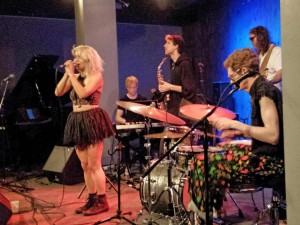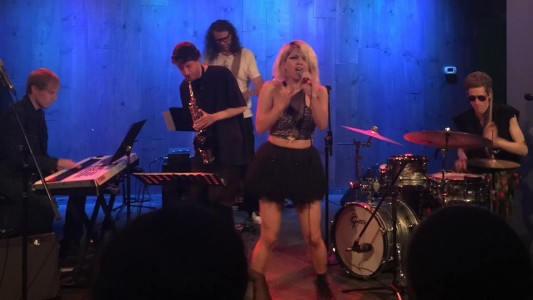
Aye, Aye…Yai
Ahab had his white whale; Hollywood Drum has its Blue Whale. A previous encounter with the Little Tokyo jazz club had us posting our first Hittin’ column in three years. That was two years ago. Last night’s encounter inspires our first post since. Curse that place! Can’t I just go enjoy some music without feeling compelled to wrestle the beast in the morning?!
Accidental euphemisms aside (tortured metaphors dead-center), it’s my Moby Dick to face down. …Dammit!
It’s not Blue Whale’s fault, really. With some of Los Angeles’ most prominent jazz venues shuttering in recent years, the improbable downtown space on the top floor of an outdoor mall has become the new big fish–hosting some of the finest improvised music in town. Yes, Joon Lee’s timing was right when he opened the doors in 2009, but timing alone doesn’t square the success of the place.
With a passion and appreciation for music and musicians immediately evident as he greets you at the door, Joon has transformed the hidden–elusive even?–corner retail box into an inviting, vibey, creativity-conducive and acoustically-sound listening room. A place musicians go to play and, along with music-lovers at large, to listen. Add a selection of small-batch whiskey and…well maybe it is Blue Whale’s fault.
Either way, here I am, coffee at hand, contemplating the musical experience and significance of the evening’s performance.
Pronunced: [Luh-feyv]
I remember meeting Tim at the bar of a Westside venue in-between Kneebody sets a few years back. He had just relocated to LA from NYC where he was an established, in-demand bassist playing with Wayne Krantz, Chris Botti, Leni Stern and Donny McCaslin. He seemed a bit unmoored at the time, connecting to a new scene and, yes, looking for work. I sensed a chuckle in his voice, intimating a confidence that things would be just fine. They are.
Since his move, he’s landed a prime gig with Tedeschi Trucks Band and, along with the Donny McCaslin Group, recorded Bowie’s brilliant adieu, Blackstar. And he’s become a Blue Whale all-star, appearing regularly with irregular configurations. This latest, The Tim Lefebvre Group, featured Jeff Babko, keys; Troy Zeigler, electronics; Dave Binney, sax; and Matt Chamberlain. Drums.
Risk Acceptance
It was billed as an “all-improv show”; which commonly translates to “we-didn’t-take-the-time-to-prepare-music-or-rehearse show”. The result is often meandering and self indulgent. (Not to suggest prepared and rehearsed precludes meandering and self indulgent.)
We associate improvisation with jazz. Rightly so. Still, that defining element of improvisation is generally relegated to soloing over the structure of a prearranged composition. Even modal or “free” jazz forms are broadly framed by this construct.
Miles Davis’ seminal jam albums, Bitches Brew and Jack Johnson, records I love, come to mind. While the extended “songs”–mostly one per side–are highly improvisational and unrestrained, there remains an outline of composition; and most of the more dramatic shifts in musical direction are edited from varied takes and further composed from the mixing board. Of course, he did perform in this style live too. But he was Miles Davis.
And you’re not.
An “all-improv show” is ambitious. And risky. And ordinarily falls flat. Lefebvre and company were extraordinary.
Sound Decisions
The floor-level stage was set with Babko’s array of keys and wires; Zeigler’s compact and alien rig of pedals and electronic controllers and more wires; Lefebvre’s comparatively stark bass rig and effect pedals and yet more wires; and Chamberlain’s…wait, this is Hollywood Drum for chrissake…
…Beautifully-antiqued copper A&F set: 18″bd, 13″tt, 16″ft, 6.5×14″ and 3×16″ snares, and 10″ timbalito. Close enough, I’m sure. A ride, large crash, two effect cymbals, primary and tiny side hats; assorted metal and hand percussion; and a couple trigger pads and a full portable mixing board and yet even more wires.
As much so as performances, this was to be about sounds. Performance. Sound. Peas. Potatoes. It’s all part of the pie, yes. A quck aside to this point:
I ride a motorcycle. For better or worse, the bike does exactly what it’s told. For better or worse.
All -improv with lots of buttons to twist means a lot of musical choices available and decisions to be made. For better or worse. Someone could get hurt.

Crappy pic #2
Rise Beyond The Occasion
Over two sets spanning approximately three hours, the outcome was transcendent. Music transcendent of its individual parts and choices and knobs and wires. Music transcendent of billing or category. Music transcendent of its location in the corner of a downtown shopping mall. Music, if you let it, to transcend body and mind. You know, great music.
Atmospheric at times. Deeply grooving at times. Melodic. Noisy. Halting, Shifting, Abrupt, Meditative. Each and all. Most tempos trended toward mid; most times, with at least one extended exception, tended toward four. But any repetition became a matter of choice, not lack of direction. Most of each set was non-stop exploration; endings, as they came, came of their own resolution. A disparate gospel blues riff somehow (Matt Chamberlain) naturally morphed into a dubstep bridge before reemerging as seamlessly.
Sorry, Kenny
The word “virtuosity” came up in passing conversation during the break. Virtuosity–excelling at one’s instrument–was not the thing at play here. Yes, each of these guys can play; they play at virtuosic levels. The idea of virtuosos convening for an all-improv jam makes me sweaty. This was decidedly not that.
As I understand it, they’d played together (with Chamberlain, at least) just once, the week before at No Name on Fairfax. The musical chemistry; depth of listening and trust; innate musicality; and fearless ability to create completely in the moment is what this was.
It’s what jazz, at its essence, is. Miles showed us decades ago that it’s not easily defined by swing or progressions or harmony or composition or style. (He employed synths, samples, and drum loops–Zeigler’s electronic rig is no less an instrument than a saxophone makes Kenny G jazz.) In fact, pure improvisation, arguably, is the epitome of jazz; and demands the truest sense of virtuosity to pull off.
As Advertised
About the drummer in the title of this post, it occurs to me that this is the second Hittin’ column bearing his name. I’ve previously felt inspired to pay him tribute on this site. It shall suffice for me to say that any superlatives regarding Matt have grown only more super with time–this was the best I’ve ever heard him. That is surely not to diminish those past times, and I hope he’d agree that he continues to grow ever more consummate as a musician.
But wait, there’s more. Matt’s integration of electronic with acoustic as a drummer, musically, is just about as good as it gets. It’d be satisfying somehow to assert the musical experience would have been equally, if differently, compelling had he been playing a four-piece Gretsch with a couple cymbals. I’m not asserting that. That’s a big deal, really. His long-standing embrace of technology has not only changed the instrument; in this setting, it’s bettered it.
Aye!
Tools matter. Try drilling into concrete without a hammer drill. But you could put an unforgivable hole in your wall if you use one to hang a picture. For better or worse.
These musicians used all of their tools, refined and polished over time, to construct a memorable night of transcendent music. Without a blueprint. A significant achievement.
So, we have our significance. And the beast lives to wrestle another day.


